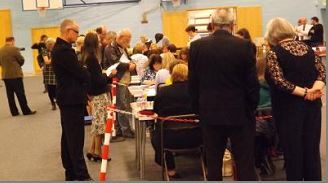In a complete reversal of more than 40 years ago, the Western Isles voted overwhelmingly to remain in the EU.
In 1975, the Western Isles voted by a massive 70 percent to 30 percent to leave the EEC.
It was one of only two regions – the other being Shetland – to then vote against staying in.
But in today’s Euro poll, islanders voted by a majority of more than 1500 to remain part of the EU.
There were 8232 votes in favour of Remain and 6671 wanting to Leave – with 16 spoilt ballot papers – a majority of 1561.
In total 14, 919 people voted out of an electorate 21, 259 – a turnout of 70.2 percent.
For the Leave Campaign, Callum Ian Macmillan admitted that the islands had benefited from massive European investment over past four decades and that may have had an effect.
But he also said that locals also had cold feet at the last minute.
“We had a very positive response during the campaign but I think that when people were in the privacy of the ballot box it was a case of better the devil you know and got cold feet,” he said.
There was also a “fuel dividend” for taxpayers over the cost of holding the vote stretching down the 130 miles chain.
The Western Isles Council saved thousands pounds on the cost of hiring a helicopter to deliver the ballot boxes from the southern isles.
It carried the ballot boxes from the islands of Barra, Vatesay, Eriskay and the Uists to the central count over 100 miles away in Stornoway.
The votes from the southern isles had to be delivered by road – and in the case of Barra, first by boat – to Benbecula where the chopper flew on to Stornoway on Lewis.
The helicopter meant that the votes from the Outer Hebrides could be declared hours earlier.
Western Isles Council spokesman Nigel Scott said the cost of the special charter was under £7000 – compared to £18,000 11 years ago.
Because of the cost, it had used a cheaper plane for the last three elections – but a helicopter operator put in a cheaper tender for the European Referendum.
“Because of falling fuel prices and increased competition the helicopter hire was cheaper this time than that of using a plane. The cost is recoverable as an election expense from central funds,” he said.
The council first used a plane to bring in the votes for the Scottish Referendum – and then the subsequent UK and Scottish parliamentary elections.
But it previously had two rather different experiences of using a helicopter.
In 2005 taxpayers paid £18,000 to hire a chopper to collect votes in the Outer Hebrides for the Westminster election.
But two years later at the Scottish Parliamentary elections, the result was not declared until Friday lunch-time after the helicopter was grounded by fog.
At various elections since, the council has relied on road and ferry to gather in the islands’ more than 21,000 votes.
Meanwhile Britain’s remotest voters on St Kilda – 112 miles off the north west Scottish mainland – were given postal votes.
The St Kilda voters are either conservation workers or employees of defence company Qinetiq, who run the missile test range based on Uist on behalf of the MoD.
Just over a dozen workers help run a tracking station on St Kilda – a double world heritage site – which monitors the missiles that are fired from Uist.
